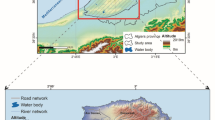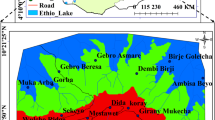Abstract
GIS-based spatial data integration tasks for predictive geological applications, such as landslide susceptibility analysis, have been regarded as one of the primary geological application issues of GIS. An efficient framework for proper representation and integration is required for this kind of application. This paper presents a data integration framework based on the Dempster-Shafer theory of evidence for landslide susceptibility mapping with multiple geospatial data. A data-driven information representation approach based on spatial association between known landslide occurrences and input geospatial data layers is used to assign mass functions. After defining mass functions for multiple geospatial data layers, Dempster’s rule of combination is applied to obtain a series of combined mass functions. Landslide susceptibility mapping using multiple geospatial data sets from Jangheung in Korea was conducted to illustrate the application of this methodology. The results of the case study indicated that the proposed methodology efficiently represented and integrated multiple data sets and showed better prediction capability than that of a traditional logistic regression model.










Similar content being viewed by others
References
An P, Moon WM, Bonham-Carter GF (1994) Uncertainty management in integration of exploration data using the belief function. Nonrenew Resour 3:60–71
Bonham-Carter GF (1994) Geographic information systems for geoscientists: modeling with GIS. Pergamon, New York
Carranza EJM, Hale M (2003) Evidential belief functions for geologically constrained mapping of gold potential, Baguio district, Philippines. Ore Geol Rev 22:117–132
Carranza EJM, Woldai T, Chikambwe EM (2005) Application of data-driven evidential belief functions to prospectivity mapping for aquamarine-bearing pegmatites, Lundazi district, Zambia. Nat Resour Res 14:14–63
Chung CF, Fabbri AG (1999) Probabilistic prediction models for landslide hazard mapping. Photogramm Eng Remote Sensing 65:1389–1399
Chung CF, Fabbri AG (2003) Validation of spatial prediction models for landslide hazard mapping. Nat Hazards 30:451–472
Dai FC, Lee CF, NG KC, Tham LG, Shun WL (2004) Logistic regression modeling of storm-induced shallow landsliding in time and space on natural terrain of Lantau Island, Hong Kong. Bull Eng Geol Environ 63:315–327
Dempster AP (1967) Upper and lower probabilities induced by a multivalued mapping. Ann Math Stat 28:325–339
Ercanoglue M, Gokceoglu C (2002) Assessment of landslide susceptibility for a landslide-prone area (north of Yenice, NW Turkey) by fuzzy approach. Environ Geol 41:720–730
Greco R, Sorriso-Valvo M, Catalano E (2007) Logistic regression analysis in the evaluation of mass movements susceptibility: the Aspromonte case study, Calabria, Italy. Eng Geol 89:47–66
Kim KS (2001) Prediction of landslide probability by geomorphic characteristics and soil properties. KIGAM Bulletin 5:29–41
Le Hégarat-Mascle S, Bloch I, Vidal-Madjar D (1999) Applicatino of Dempster-Shafer evidence theory to unsupervised classification in multisource remote sensing. IEEE Trans Geosci Remote Sens 35:1018–1031
Lee S (2005) Application of logistic regression model and its validation for landslide susceptibility mapping using GIS and remote sensing data. Int J Remote Sens 26:1477–1491
Lee S (2007) Landslide susceptibility mapping using an artificial neural network in the Gangneung area, Korea. Int J Remote Sens 28:4763–4783
Lee S, Min K (2001) Statistical analysis of landslide susceptibility at Yongin, Korea. Env Geol 40:1095–1113
Lee S, Pradhan B (2007) Landslide hazard mapping at Selangor, Malaysia using frequency ratio and logistic regression models. Landslides 4:33–41
Lee S, Sambath T (2006) Landslide susceptibility mapping in the Damrei Romel area, Cambodia using frequency ratio and logistic regression models. Env Geol 50:847–855
Lee T, Richards JA, Swain PH (1987) Probabilistic and evidential approaches for multisource data analysis. IEEE Trans Geosci Remote Sens 25:283–293
Lee BJ, Kim YB, Lee SR, Kim JC, Kang PJ, Choi HI, Jin MS (1999) Explanatory note of the Seoul-Namchonjeom sheet (1:250, 000). Korea Institute of Geology, Mining and Materials, Daejeon
Luzi L, Floriana P (1996) Application of statistical and GIS techniques for slope instability zonation (1:50, 000 Fabriano geological map sheet). Soil Dyn Earthq Eng 15:83–94
Moon WM (1990) Integration of geophysical and geological data using evidential belief function. IEEE Trans Geosci Remote Sens 28:711–720
Moon WM (1993) On mathematical representation and integration of multiple spatial geoscience data sets. Can J Remote Sens 19:251–255
Park NW, Chi KH (2008) Quantitative assessment of landslide susceptibility using high-resolution remote sensing data and a generalized additive model. Int J Remote Sens 29:247–264
Park NW, Chi KH, Chung CF, Kwon BD (2003) Application of spatial data integration based on the likelihood ratio function and Bayesian rule for landslide hazard mapping. J Korean Earth Sci Soc 24:428–439
Rottensteiner F, Trinder J, Clode S, Kubik K (2004) Using the Dempster-Shafer method for the fusion of LIDAR data and multi-spectral images for building detection. Inf Fusion 6:283–300
Shafer G (1976) A mathematical theory of evidence. Princeton University Press, Princeton
Shi G (1994) Evidential reasoning for geological mapping with multisource spatial data. Master thesis, The University of Calgary
Yao X, Tham LG, Dai FC (2008) Landslide susceptibility mapping based on support vector machine: a case study on natural slopes of Hong Kong, China. Geomorpholoy 101:572–582
Acknowledgments
This work was supported by INHA UNIVERSITY Research Grant (INHA-40227). The author would like to thank Dr. C.F. Chung of Geological Survey of Canada for his comments on validation for predictive spatial data integration.
Author information
Authors and Affiliations
Corresponding author
Rights and permissions
About this article
Cite this article
Park, NW. Application of Dempster-Shafer theory of evidence to GIS-based landslide susceptibility analysis. Environ Earth Sci 62, 367–376 (2011). https://doi.org/10.1007/s12665-010-0531-5
Received:
Accepted:
Published:
Issue Date:
DOI: https://doi.org/10.1007/s12665-010-0531-5




